1 of 11
Download to read offline

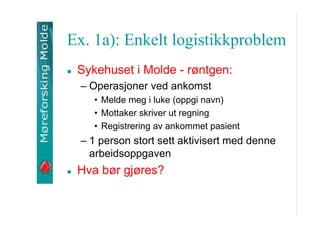
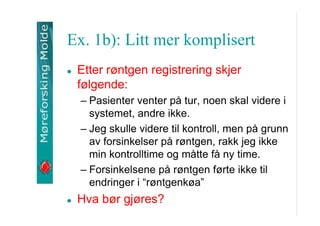
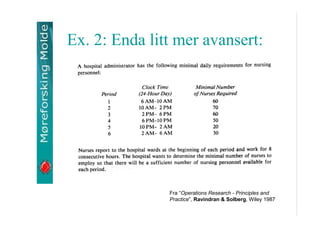
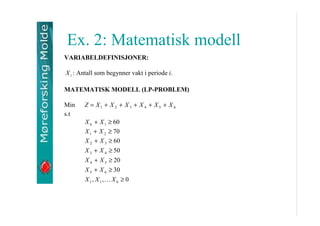


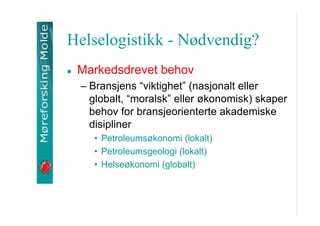
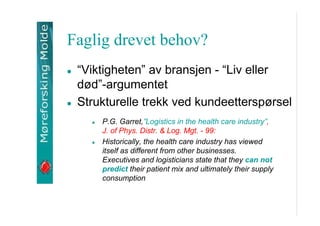
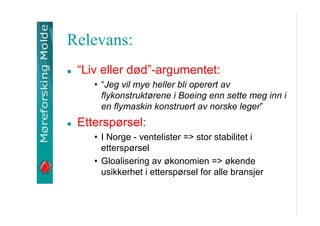

Ad
Recommended
Paris september2009
Paris september2009Kjetil Haugen
?
This document presents a game theory approach to analyzing financial problems in European club football. It summarizes revenue and profit/loss figures for major football leagues from 2001-2008. It then introduces a model that frames talent acquisition decisions as a 2-player simultaneous game between clubs. The model finds two possible Nash equilibria - both clubs acquiring talent for profit maximization or win maximization. Relaxing the model's assumptions allows for additional equilibria depending on differences in club revenues and talent costs. The model provides a simplified framework for analyzing how regulation could address structural differences between European and U.S. sports leagues.Dynpri brno
Dynpri brnoKjetil Haugen
?
This document discusses dynamic pricing strategies for monopolies. It begins with background on classic monopoly models assuming linear demand and costs. It then presents a mathematical programming formulation to model dynamic pricing as a nonlinear program over multiple time periods. The model is compared for cases of fixed pricing, single variable price, discrete price choices, and fully dynamic continuous pricing. Solving the cases for an example shows that profits increase from 43% as pricing becomes more dynamic. Factors like demand variability, storage costs, and capacity constraints affect the potential benefits. Dynamic pricing may not be optimal in perfectly competitive markets and risks must be considered in oligopolistic environments. The document concludes with potential extensions like multiple products, setup costs, and uncertainty.Iase 2006
Iase 2006Kjetil Haugen
?
This document presents an economic model of player trades between two sports teams (T1 and T2) using a game theoretic approach. It assumes the teams are marginally different in playing strength and must simultaneously decide whether to buy the other team's player. The model finds there are two Nash equilibria - if revenue from points scored is convex, T1 buys from T2, and if revenue is concave, T2 buys from T1. This preserves competition given revenue is typically assumed to be concave. Further work could expand the model to include more teams, a league structure, incomplete information, or apply it to other labor markets.Weioti
WeiotiKjetil Haugen
?
This document discusses scientific production and the academic system in Norway. It begins with an overview of the Norwegian academic system, which is divided into universities, specialized universities, and university colleges based on PhD activity levels. Scientific production is then analyzed based on publication credits from 2008 to 2012. Molde University College, a specialized university, increased its publication credits over this period and in 2012 compared favorably to other specialized universities in Norway. Student enrollment statistics for bachelor's and master's degrees are also presented.Pde brno
Pde brnoKjetil Haugen
?
This document summarizes a game theory model of doping in competitive sports. It makes the following key points:
1) The model frames doping as a prisoner's dilemma game, where the dominant strategy for both athletes is to dope, even though not doping would be better for both.
2) For the non-doping equilibrium to occur, the probability of getting caught r must be greater than half the benefit of winning divided by the cost of getting caught c.
3) If one athlete is believed to be inherently better, doping may not have a pure strategy equilibrium, only a mixed strategy one, making doping even harder to prevent.
4) Uncertainty over drug effectsRussia
RussiaKjetil Haugen
?
The document discusses scientific production and academic rankings within the Norwegian higher education system. It provides details on the institutional structure, which includes universities, specialized universities, and university colleges. Scientific production is measured by publication credits. Data shows that Molde University College, a specialized university, has steadily increased its publication credits from 2004-2012 to surpass other specialized universities and approach publication levels at full universities. Student enrollment statistics for bachelor's and master's programs are also presented.Kurt60 bergen
Kurt60 bergenKjetil Haugen
?
This document summarizes Kjetil Haugen and Bj?rn Nygreen's connections to Kurt M. Frederiksen and their work applying mathematical programming to Norwegian petroleum field and pipeline planning. It describes early discrete deterministic models used in the 1980s to maximize NPV and meet production targets. Stochastic models were later developed to account for uncertainty. The original deterministic structure is still used in current planning models. The document congratulates Kurt on his 60th birthday and impact on their institutions over many years.1. Introduction to Irish Labour History 1889-1924
1. Introduction to Irish Labour History 1889-1924Conor McCabe
?
This document provides information on the HHIS403 course "Political & Social Movements in Twentieth-Century Ireland" focusing on the Irish Labour Movement from 1889-1924. The course schedule and required reading are listed. Key figures to be discussed include Jim Larkin, James Connolly, and their roles in organizing workers and events like the 1913 Lockout. Supplementary reading materials on topics like syndicalism and the evolution of the Irish labor movement are also provided.Bolkesjoe seminar-230300
Bolkesjoe seminar-230300Kjetil Haugen
?
A completely failure talk for most medical doctors in Norway, Trying to argue that Norwegian doctors are unproductive :-)Bergen2009
Bergen2009Kjetil Haugen
?
The document discusses the "publish or perish" perspective of PhD education and whether an emphasis on publishing produces better PhD students. It argues that the publishing process itself is lengthy, tedious, and not conducive to creativity. Modern PhD students are pressured to publish 3-5 papers, often of low quality and with the supervisor as a co-author, focusing more on formatting papers in different ways rather than generating new ideas. The author is skeptical of this approach and believes PhD education should minimize publishing requirements and allow students to take risks and potentially fail, in order to foster creativity rather than forcing students into the "publish or perish" mindset too early.The New Classroom
The New ClassroomJoe Johnson
?
The document discusses the history of formal learning relationships and education technology. It notes that ancient learning involved a master-guru and disciple relationship. In medieval times, the relationship was between a doctor and student-novice. During colonial times, it was a teacher-pupil relationship. The document then outlines some key developments in distance education including the University of Chicago mailing lessons in the 1850s, satellite TV courses in the 1980s, and the arrival of the first learning management system called FirstClass in 1990.Fcc networks paperprintversion
Fcc networks paperprintversiontomcopeland1
?
This document discusses staffed family child care networks as a strategy to enhance the quality of care for infants and toddlers. It defines staffed family child care networks as programs that employ at least one paid staff person to provide ongoing oversight and support to family child care providers. The document reviews research finding that provider affiliation with a staffed network is associated with higher quality care. It also identifies specific network practices, such as home visits and onsite training, that are most promising for improving family child care quality. Finally, it provides recommendations for implementing and integrating staffed family child care networks into early childhood systems.WSO2Con - Integrating Telecom Big Data: Challenges and Lessons Learned
WSO2Con - Integrating Telecom Big Data: Challenges and Lessons LearnedFab©¬ola Fernandes
?
This document discusses Algar Telecom's Coreo platform, which is a dynamic platform for composing telecom applications. It outlines Coreo's architecture, which uses messaging passing and stateless storage to allow distributed and scalable apps. Some lessons learned include the importance of data-driven decisions and adapting legacy systems. Challenges include effectively using big data and dealing with existing telecom platforms. Overall, Coreo aims to enable telecom innovation through a platform built on open source WSO2 tools.Elements of Drama
Elements of DramaJoe Johnson
?
The document outlines Aristotle's four elements of tragedy: plot, character, theme, and diction, detailing their roles in storytelling. It emphasizes the importance of plot structure, character dynamics, the underlying themes, and the choice of words. Additionally, it touches on aspects such as point of view, setting, and symbolism in fiction.Global Financing Facility (GFF) in Support of Every Woman Every Child Worksho...
Global Financing Facility (GFF) in Support of Every Woman Every Child Worksho...Global Financing Facility in support of Every Woman Every Child
?
This document discusses using a commodity lens to inform investment cases for the Global Financing Facility (GFF). It summarizes efforts to increase access to reproductive health commodities and identifies bottlenecks. Global initiatives like the UN Commission on Life Saving Commodities and the Implant Access Program have increased availability but country data shows gaps remain. Dashboards are presented to rate countries on commodity indicators and identify weak areas like guidelines, stockouts, training and data collection. Analyzing commodity pathways can help strengthen health systems and inform priority actions in national plans to further expand access and coverage of maternal, newborn and child health commodities."The Changing World Is Enabling New Patient Partnerships"
"The Changing World Is Enabling New Patient Partnerships"e-Patient Dave deBronkart
?
This document profiles Dave deBronkart, known as "e-Patient Dave", a cancer survivor and advocate for engaged, empowered patients. It discusses how the rise of the internet and digital connectivity has shifted where medical information and expertise can be found, allowing patients to connect with each other and participate more actively in their own care. It argues that patients should have access to their own clear medical data and notes several examples of how patient engagement and empowerment can improve health outcomes.springAngel Ruiz
?
Spring es un framework de c©«digo abierto que facilita el desarrollo de aplicaciones Java mediante la Inversi©«n de Control (IoC) y la Programaci©«n Orientada a Aspectos (AOP). IoC permite definir las dependencias entre los componentes de una aplicaci©«n de forma declarativa en lugar de mediante c©«digo. Spring proporciona dos contenedores principales, BeanFactory y ApplicationContext, que gestionan el ciclo de vida de los objetos y resuelven sus dependencias de acuerdo a la configuraci©«n XML.±R┐╔░╦š┬ppt (╔ŽV2)
±R┐╔░╦š┬ppt (╔ŽV2)▓ķŠŁ╝“▒©ĘųŽĒ
?
┬Ē┐╔ĖŻę¶Ą┌░╦š┬├Ķ╩÷┴╦ę«Ędė├Ų▀Ė÷▒²║═╝Ė╠§ąĪėŃj▒źį╝╦─Ū¦╚╦Ą─╔±█öŻ¼ęį╝░├┼═ĮČįņČ╔±█öĄ─Ę┤ė│║═ę╔╗¾ĪŻę«ĘdŠ»Ėµ├┼═Įę¬Ę└▒ĖĘ©└¹╚³╚╦Ą─Į═Ż¼Ū┐Ą„ą┼č÷Ą─┤┐┤Ōąį║═Čį╔±Ą─ą┼╚╬ĪŻ╬─▒Š╠Į╠ų┴╦╚╦├Ūį┌├µČįąĶŪ¾╩▒Ą─Ę┤ė”Ż¼ęį╝░ą┼č÷╔·╗ŅųąąĶꬊ»╠ĶĄ─ė░Žņ┴”ĪŻUsikkerhet, verdi av flesibilitet og innfasing av petroleumsprosjekter
Usikkerhet, verdi av flesibilitet og innfasing av petroleumsprosjekterKjetil Haugen
?
The title says it allPrivate vs. Public Cost-Benefit in Scheduling Petroleum projects - The case o...
Private vs. Public Cost-Benefit in Scheduling Petroleum projects - The case o...Kjetil Haugen
?
This document discusses private versus public cost-benefit analysis in scheduling petroleum projects under uncertainty. It presents deterministic and stochastic examples comparing different scheduling approaches (S, L, and M) and how they are impacted by uncertainty and risk attitudes. It argues that accounting for uncertainty and risk in a stochastic optimization framework provides more accurate cost-benefit assessments than deterministic analyses and better informs public policy and industry decisions.MIlj?integrasjon i Logistikkmodeller
MIlj?integrasjon i LogistikkmodellerKjetil Haugen
?
A rare presentation on Green Logistics - at some NFR conferenceSamfunns?konomiske konsekvenser av anleggsinvesteringer i fotballbransjen
Samfunns?konomiske konsekvenser av anleggsinvesteringer i fotballbransjenKjetil Haugen
?
Talking to the top level group in Norwegian football on why they all should build new stadiums.Struktur adferd og regulering i intermodale transportkorridorer
Struktur adferd og regulering i intermodale transportkorridorerKjetil Haugen
?
A talk on an old paper on game theory an intermodal transportation.More Related Content
Viewers also liked (16)
Russia
RussiaKjetil Haugen
?
The document discusses scientific production and academic rankings within the Norwegian higher education system. It provides details on the institutional structure, which includes universities, specialized universities, and university colleges. Scientific production is measured by publication credits. Data shows that Molde University College, a specialized university, has steadily increased its publication credits from 2004-2012 to surpass other specialized universities and approach publication levels at full universities. Student enrollment statistics for bachelor's and master's programs are also presented.Kurt60 bergen
Kurt60 bergenKjetil Haugen
?
This document summarizes Kjetil Haugen and Bj?rn Nygreen's connections to Kurt M. Frederiksen and their work applying mathematical programming to Norwegian petroleum field and pipeline planning. It describes early discrete deterministic models used in the 1980s to maximize NPV and meet production targets. Stochastic models were later developed to account for uncertainty. The original deterministic structure is still used in current planning models. The document congratulates Kurt on his 60th birthday and impact on their institutions over many years.1. Introduction to Irish Labour History 1889-1924
1. Introduction to Irish Labour History 1889-1924Conor McCabe
?
This document provides information on the HHIS403 course "Political & Social Movements in Twentieth-Century Ireland" focusing on the Irish Labour Movement from 1889-1924. The course schedule and required reading are listed. Key figures to be discussed include Jim Larkin, James Connolly, and their roles in organizing workers and events like the 1913 Lockout. Supplementary reading materials on topics like syndicalism and the evolution of the Irish labor movement are also provided.Bolkesjoe seminar-230300
Bolkesjoe seminar-230300Kjetil Haugen
?
A completely failure talk for most medical doctors in Norway, Trying to argue that Norwegian doctors are unproductive :-)Bergen2009
Bergen2009Kjetil Haugen
?
The document discusses the "publish or perish" perspective of PhD education and whether an emphasis on publishing produces better PhD students. It argues that the publishing process itself is lengthy, tedious, and not conducive to creativity. Modern PhD students are pressured to publish 3-5 papers, often of low quality and with the supervisor as a co-author, focusing more on formatting papers in different ways rather than generating new ideas. The author is skeptical of this approach and believes PhD education should minimize publishing requirements and allow students to take risks and potentially fail, in order to foster creativity rather than forcing students into the "publish or perish" mindset too early.The New Classroom
The New ClassroomJoe Johnson
?
The document discusses the history of formal learning relationships and education technology. It notes that ancient learning involved a master-guru and disciple relationship. In medieval times, the relationship was between a doctor and student-novice. During colonial times, it was a teacher-pupil relationship. The document then outlines some key developments in distance education including the University of Chicago mailing lessons in the 1850s, satellite TV courses in the 1980s, and the arrival of the first learning management system called FirstClass in 1990.Fcc networks paperprintversion
Fcc networks paperprintversiontomcopeland1
?
This document discusses staffed family child care networks as a strategy to enhance the quality of care for infants and toddlers. It defines staffed family child care networks as programs that employ at least one paid staff person to provide ongoing oversight and support to family child care providers. The document reviews research finding that provider affiliation with a staffed network is associated with higher quality care. It also identifies specific network practices, such as home visits and onsite training, that are most promising for improving family child care quality. Finally, it provides recommendations for implementing and integrating staffed family child care networks into early childhood systems.WSO2Con - Integrating Telecom Big Data: Challenges and Lessons Learned
WSO2Con - Integrating Telecom Big Data: Challenges and Lessons LearnedFab©¬ola Fernandes
?
This document discusses Algar Telecom's Coreo platform, which is a dynamic platform for composing telecom applications. It outlines Coreo's architecture, which uses messaging passing and stateless storage to allow distributed and scalable apps. Some lessons learned include the importance of data-driven decisions and adapting legacy systems. Challenges include effectively using big data and dealing with existing telecom platforms. Overall, Coreo aims to enable telecom innovation through a platform built on open source WSO2 tools.Elements of Drama
Elements of DramaJoe Johnson
?
The document outlines Aristotle's four elements of tragedy: plot, character, theme, and diction, detailing their roles in storytelling. It emphasizes the importance of plot structure, character dynamics, the underlying themes, and the choice of words. Additionally, it touches on aspects such as point of view, setting, and symbolism in fiction.Global Financing Facility (GFF) in Support of Every Woman Every Child Worksho...
Global Financing Facility (GFF) in Support of Every Woman Every Child Worksho...Global Financing Facility in support of Every Woman Every Child
?
This document discusses using a commodity lens to inform investment cases for the Global Financing Facility (GFF). It summarizes efforts to increase access to reproductive health commodities and identifies bottlenecks. Global initiatives like the UN Commission on Life Saving Commodities and the Implant Access Program have increased availability but country data shows gaps remain. Dashboards are presented to rate countries on commodity indicators and identify weak areas like guidelines, stockouts, training and data collection. Analyzing commodity pathways can help strengthen health systems and inform priority actions in national plans to further expand access and coverage of maternal, newborn and child health commodities."The Changing World Is Enabling New Patient Partnerships"
"The Changing World Is Enabling New Patient Partnerships"e-Patient Dave deBronkart
?
This document profiles Dave deBronkart, known as "e-Patient Dave", a cancer survivor and advocate for engaged, empowered patients. It discusses how the rise of the internet and digital connectivity has shifted where medical information and expertise can be found, allowing patients to connect with each other and participate more actively in their own care. It argues that patients should have access to their own clear medical data and notes several examples of how patient engagement and empowerment can improve health outcomes.springAngel Ruiz
?
Spring es un framework de c©«digo abierto que facilita el desarrollo de aplicaciones Java mediante la Inversi©«n de Control (IoC) y la Programaci©«n Orientada a Aspectos (AOP). IoC permite definir las dependencias entre los componentes de una aplicaci©«n de forma declarativa en lugar de mediante c©«digo. Spring proporciona dos contenedores principales, BeanFactory y ApplicationContext, que gestionan el ciclo de vida de los objetos y resuelven sus dependencias de acuerdo a la configuraci©«n XML.±R┐╔░╦š┬ppt (╔ŽV2)
±R┐╔░╦š┬ppt (╔ŽV2)▓ķŠŁ╝“▒©ĘųŽĒ
?
┬Ē┐╔ĖŻę¶Ą┌░╦š┬├Ķ╩÷┴╦ę«Ędė├Ų▀Ė÷▒²║═╝Ė╠§ąĪėŃj▒źį╝╦─Ū¦╚╦Ą─╔±█öŻ¼ęį╝░├┼═ĮČįņČ╔±█öĄ─Ę┤ė│║═ę╔╗¾ĪŻę«ĘdŠ»Ėµ├┼═Įę¬Ę└▒ĖĘ©└¹╚³╚╦Ą─Į═Ż¼Ū┐Ą„ą┼č÷Ą─┤┐┤Ōąį║═Čį╔±Ą─ą┼╚╬ĪŻ╬─▒Š╠Į╠ų┴╦╚╦├Ūį┌├µČįąĶŪ¾╩▒Ą─Ę┤ė”Ż¼ęį╝░ą┼č÷╔·╗ŅųąąĶꬊ»╠ĶĄ─ė░Žņ┴”ĪŻGlobal Financing Facility (GFF) in Support of Every Woman Every Child Worksho...
Global Financing Facility (GFF) in Support of Every Woman Every Child Worksho...Global Financing Facility in support of Every Woman Every Child
?
More from Kjetil Haugen (16)
Usikkerhet, verdi av flesibilitet og innfasing av petroleumsprosjekter
Usikkerhet, verdi av flesibilitet og innfasing av petroleumsprosjekterKjetil Haugen
?
The title says it allPrivate vs. Public Cost-Benefit in Scheduling Petroleum projects - The case o...
Private vs. Public Cost-Benefit in Scheduling Petroleum projects - The case o...Kjetil Haugen
?
This document discusses private versus public cost-benefit analysis in scheduling petroleum projects under uncertainty. It presents deterministic and stochastic examples comparing different scheduling approaches (S, L, and M) and how they are impacted by uncertainty and risk attitudes. It argues that accounting for uncertainty and risk in a stochastic optimization framework provides more accurate cost-benefit assessments than deterministic analyses and better informs public policy and industry decisions.MIlj?integrasjon i Logistikkmodeller
MIlj?integrasjon i LogistikkmodellerKjetil Haugen
?
A rare presentation on Green Logistics - at some NFR conferenceSamfunns?konomiske konsekvenser av anleggsinvesteringer i fotballbransjen
Samfunns?konomiske konsekvenser av anleggsinvesteringer i fotballbransjenKjetil Haugen
?
Talking to the top level group in Norwegian football on why they all should build new stadiums.Struktur adferd og regulering i intermodale transportkorridorer
Struktur adferd og regulering i intermodale transportkorridorerKjetil Haugen
?
A talk on an old paper on game theory an intermodal transportation.Pclsp ntnu
Pclsp ntnuKjetil Haugen
?
The document introduces the profit maximizing capacitated lot-size problem with pricing (PCLSP) as a generalization of the capacitated lot-sizing problem (CLSP) that allows for pricing decisions. It presents the formulation and characteristics of PCLSP and describes how it is computationally more tractable than CLSP by introducing pricing variables. The document outlines a Lagrange relaxation algorithm for solving PCLSP using lower and upper bound subproblems and presents results showing PCLSP solves faster with smaller optimality gaps than CLSP on example problems. It discusses the practical relevance of PCLSP under different market conditions.Nsw rio
Nsw rioKjetil Haugen
?
This document provides an overview of a game theoretic framework for analyzing soccer game strategies. It introduces some basic assumptions about soccer games and presents a simple model with two teams that must choose between offensive and defensive strategies. The framework is then applied to historic matchups between Norway and Brazil and Norway and Belarus. The analysis finds that for a weaker team like Belarus, mimicking Norway's preferred strategy may yield better results. Interestingly, the document also suggests that decreasing one's own performance in their preferred strategy could paradoxically lead to better outcomes for both teams in some cases. This potential for "adverse behavior" is discussed as a possible explanation for certain unexpected soccer results.Island
IslandKjetil Haugen
?
This document discusses reasons for the lack of real-world applications of operations research (OR), especially stochastic optimization. It presents three explanations specific to stochastic optimization: 1) The need for more data collection and estimation increases costs and disagreements. 2) Contingent solutions based on future uncertainties involve "contingency costs" above deterministic solutions. 3) In competitive situations, stochastic strategies can be a sure losing strategy if other agents do not consider uncertainties. Managers' reluctance to use stochastic optimization may be rational considering these real-world complexities.Heilbron
HeilbronKjetil Haugen
?
This document analyzes the relationship between foreign players in European club football and the quality of national teams. It finds that for some countries like England, having more foreign players in their domestic leagues is positively correlated with national team performance over time. For countries like France, Norway, and Greece, having more of their domestic players playing abroad for foreign clubs is positively correlated with national team quality. However, the document notes there could be other factors involved and the relationships require more analysis.Gt brno
Gt brnoKjetil Haugen
?
This document provides an introduction to simple game theory concepts including Nash equilibrium, dominant strategies, and mixed strategies. It summarizes key ideas from a course on game theory and soccer held in Brno, Czech Republic in May 2005. The document uses examples like a game between two newspapers choosing front page stories and a Cournot model of duopolistic competition to illustrate game theory concepts like best responses, dominant strategies, and finding a Nash equilibrium involving mixed strategies.Ffp pres
Ffp presKjetil Haugen
?
This document discusses UEFA's Financial Fair Play regulations aimed at improving financial sustainability in European football clubs. It presents a game theory model of clubs in a prisoner's dilemma situation where overspending on players is the dominant strategy. The regulations aim to break this cycle by limiting club expenses to income, but modeling suggests they create new incentives for clubs to bypass rules through additional costs, potentially reducing competitive balance. While problems are inevitable initially, the long term goal is to reduce dependence on benefactors and introduce more rational finances.Easm 2008
Easm 2008Kjetil Haugen
?
The document discusses the globalization of soccer, highlighting Arsenal's record of fielding a team with players from 11 nationalities. It outlines a game-theoretic model exploring player migration and the financial implications of buying foreign versus local players, along with analyzing win-maximization versus profit-maximization in European and US sports contexts. The findings suggest that while clubs may prefer foreign players for income generation, other factors, such as club wealth and regional differences, impact player acquisition strategies.Ceske budevice
Ceske budeviceKjetil Haugen
?
The document describes an algorithm for solving the single item profit maximizing capacitated lot-size problem (PCLSP) with fixed prices and no set-up costs. The algorithm works as follows:
1. Calculate the optimal "chase demand" solution without capacity constraints.
2. If this solution is feasible, it is optimal. Otherwise, identify periods where capacity is exceeded.
3. Produce as close as possible to the violating period to minimize total inventory. Move production earlier in periods until all constraints are satisfied.
Simple tests show the algorithm runs significantly faster than commercial solvers, making it useful for large problem instances or as a sub-routine in other applications.Ad
Hsm seminar 210901
- 1. Ī░HELSELOGISTIKKĪ▒ - Hva er det? Kjetil Haugen Seminar 21. September 2001 - HSM
- 2. Ex. 1a): Enkelt logistikkproblem Sykehuset i Molde - r?ntgen: ©C Operasjoner ved ankomst ? Melde meg i luke (oppgi navn) ? Mottaker skriver ut regning ? Registrering av ankommet pasient ©C 1 person stort sett aktivisert med denne arbeidsoppgaven Hva b?r gj?res?
- 3. Ex. 1b): Litt mer komplisert Etter r?ntgen registrering skjer f?lgende: ©C Pasienter venter p? tur, noen skal videre i systemet, andre ikke. ©C Jeg skulle videre til kontroll, men p? grunn av forsinkelser p? r?ntgen, rakk jeg ikke min kontrolltime og m?tte f? ny time. ©C Forsinkelsene p? r?ntgen f?rte ikke til endringer i Ī░r?ntgenk?aĪ▒ Hva b?r gj?res?
- 4. Ex. 2: Enda litt mer avansert: Fra Ī░Operations Research - Principles and PracticeĪ▒, Ravindran & Solberg, Wiley 1987
- 5. Ex. 2: Matematisk modell VARIABELDEFINISJONER: X i : Antall som begynner vakt i periode i. MATEMATISK MODELL (LP-PROBLEM) Min s.t Z = X1 + X 2 + X 3 + X 4 + X 5 + X 6 X 6 + X 1 Ī▌ 60 X 1 + X 2 Ī▌ 70 X 2 + X 3 Ī▌ 60 X 3 + X 4 Ī▌ 50 X 4 + X 5 Ī▌ 20 X 5 + X 6 Ī▌ 30 X 1 , X 1 ,ĪŁ X 6 Ī▌ 0
- 6. Ex. 2: L?sning X 1* 60 * X2 10 * X3 50 * X4 0 * X5 30 * X6 0 Z* 150
- 7. Helselogistikk - N?dvendig? Faglig drevet behov ©C Bransjen og problemstrukturer er s? forskjellig fra andre bransjer at teori og metodikk blir signifikant forskjellige. ? Kvantemekanikk ? Regional?konomi ? Ressurs?konomi
- 8. Helselogistikk - N?dvendig? Markedsdrevet behov ©C Bransjens Ī░viktighetĪ▒ (nasjonalt eller globalt, Ī░moralskĪ▒ eller ?konomisk) skaper behov for bransjeorienterte akademiske disipliner ? Petroleums?konomi (lokalt) ? Petroleumsgeologi (lokalt) ? Helse?konomi (globalt)
- 9. Faglig drevet behov? Ī░ViktighetenĪ▒ av bransjen - Ī░Liv eller d?dĪ▒-argumentet Strukturelle trekk ved kundeettersp?rsel P.G. Garret,Ī▒Logistics in the health care industryĪ▒, J. of Phys. Distr. & Log. Mgt. - 99: Historically, the health care industry has viewed itself as different from other businesses. Executives and logisticians state that they can not predict their patient mix and ultimately their supply consumption
- 10. Relevans: Ī░Liv eller d?dĪ▒-argumentet: ? Ī░Jeg vil mye heller bli operert av flykonstrukt?rene i Boeing enn sette meg inn i en flymaskin konstruert av norske legerĪ▒ Ettersp?rsel: ? I Norge - ventelister => stor stabilitet i ettersp?rsel ? Gloalisering av ?konomien => ?kende usikkerhet i ettersp?rsel for alle bransjer
- 11. Konklusjon: Hvis behov: Markedsdrevet Underst?ttelse: (DN 21/2-01) ĪŁ I Norge kan det v?re leger. Eller andre profesjoner, som havner i direkt?rstolen mer eller mindre tilfeldig gjerne i mer moden alderĪŁ. ĪŁ Det er ingen annen vei inn i ledelsen av et sykehus enn denne skolen (Ecole Nationale de la Sante Publique). Hos oss har ikke legene stor innflytelse p? styringen av sykehus og helsevesen. Legene har en annen jobb ? gj?reĪŁ.. ĪŁI Frankrike bruker en kirurg rundt 60% av tiden ved operasjonsbordet. I Norge ligger andelen rundt 20%ĪŁ.
